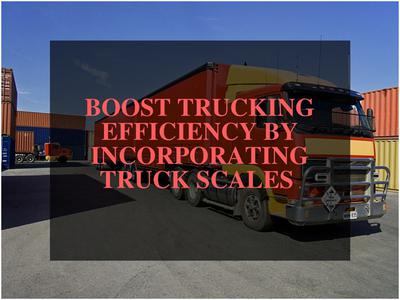Boost Trucking Efficiency by Incorporating Truck Scales
by Kevin Hill
(California)
Truck scales are slowly becoming a staple component in various industries due to the number of advantages they offer. They offer a variety of weighing options that enable you to increase efficiency in your facility. Let us look at the different types of truck scales and how they can benefit you.
How Can We Classify Truck Scales?
There are a number of methods in which you can weigh a truck. There are two general ways to do so -
1. One-Axle Weighing
2. One-Stop Truck Weighing
With the former, you can drive the vehicle slowly on to the scale and stop each time when one set of wheels is positioned on the weigh deck. The weight of the vehicle is calculated by adding the individual calculations. When you want to use the one-stop truck weighing process, you have to place the whole vehicle all at once on the weigh deck. There are two basic classifications of truck scales — a full-length scale or an axle truck scale. Let us learn a bit more about them:
• Full-Length Truck Scales
These scales can either be low profile, pit, steel or concrete deck, electromechanical, full-electronic or check cod restraint. Different types of full-length truck scales are used for weighing different materials. Full length-truck scales are generally a lot more expensive than most of the truck scales that are available.
• Axle Truck Scales
Axle truck scales are really popular as they are portable and convenient, in spite of not being as accurate as the full-length truck scales. They can be installed quite easily and can be placed either above the ground level or inside a pit. If you want to tailor some axle truck scales to your needs and industry, it is possible to do so.
How Weigh-In-Motion Scales Help in Increasing Onsite Efficiency
Weigh-in motion (WIM) scales are being implemented in several businesses due to
You can install the weigh-in motion scales as a replacement to the static in-ground scales, which require the drivers to stop on the scales manually to receive a weight. Similarly, large static scales also require the incoming drivers to wait in line for a long time until their turn comes at the entry. This significantly reduces and limits the throughput. Your annual maintenance costs may also increase due the large size and complexity of the older static truck scales. Further, they can also be integrated with printers, overhead displays and traffic lights, RFID and cloud based software along with cameras, audio integration. This helps in recording data and remote viewing.
Regardless of the industry you are in, whether it is mining, agriculture, manufacturing or farming, you will greatly benefit from buying truck scales. When you incorporate truck scales in your facility, you will undoubtedly observe an increased efficiency in all your operations. Truck scales allow you to unload your goods and weigh them at the same place, which eliminates a number of redundant steps that otherwise would be a part of the processes if the truck scales are located away from the loading and unloading docks. Truck scale maintenance is equally important to get efficient and accurate results, so ensure that you implement good maintenance practices.
Autho Bio:
Kevin Hill heads up the marketing efforts and provides technical expertise to the sales and service teams at Quality Scales Unlimited in Byron, California. He enjoys everything mechanical and electronic, computers, the internet and spending time with family. Visit http://www.scalesu.com/ for more info.
Comments for Boost Trucking Efficiency by Incorporating Truck Scales
|
||
|
||





